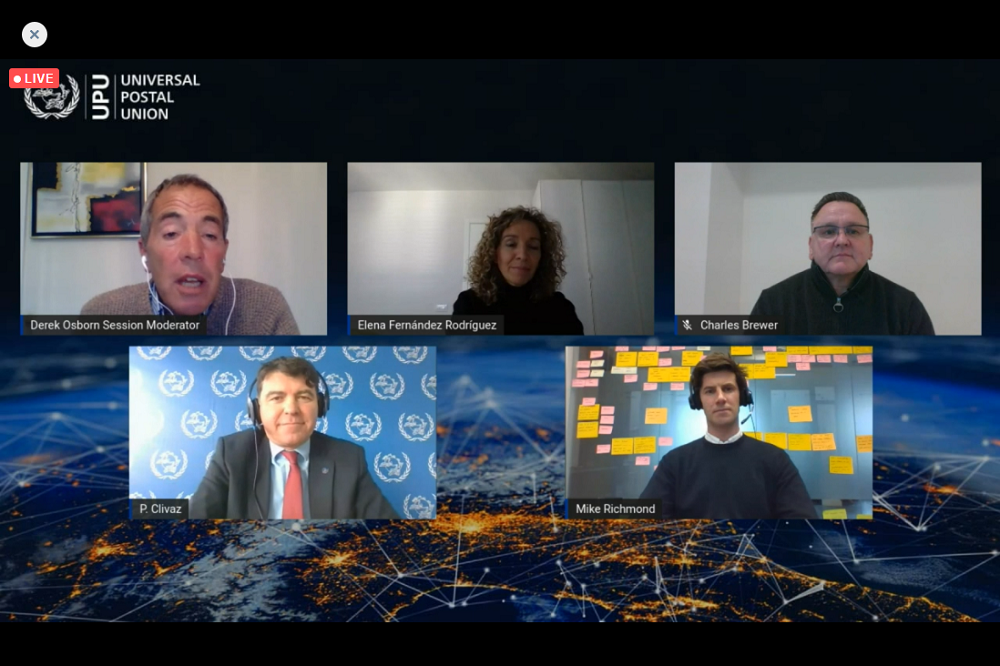Capacity tops postal operators’ agenda amid e-commerce boom

Bottom: Pascal Clivaz, Mike Richmond
Posts need to expand parcel capacity substantially in the coming years to successfully deliver soaring volumes resulting from the boom in e-commerce generated by the COVID-19 pandemic, top managers made clear at this week’s Parcel + Post-Expo online conference.
At the same time, sustainable deliveries will become a ‘must-have’ rather than a ‘nice to have’ to avoid rising volumes resulting in increasing numbers of delivery vehicles in urban centres, managers from Canada Post, Correos, Doddle and the UPU emphasised during a UPU Forum panel discussion.
Meanwhile, securing international transportation capacity by air or alternative modes will remain vital to ensuring that cross-border e-commerce can continue its rapid growth, they agreed. Big postal operators such as China Post and the USPS were forced to send international volumes by ocean while others turned to rail in recent months as airlines grounded the bulk of their flights at the peak of the pandemic.
Pascal Clivaz, Deputy Director General of the UPU, explained how the UPU had held talks with IATA to encourage airlines to offer cargo solutions to keep goods flowing while also working with other international organisations, such as the international railways association.
“We have started a very fruitful cooperation with the railways. We are moving tonnes and tonnes from China to Europe through the railways,” he pointed out.
Kayaks and barbecues at Canada Post
Outlining how the pandemic had affected postal operators, Charles Brewer, COO at Canada Post, said the company’s parcel volumes had accelerated from “single-digit, low double-digit growth to 10x in volumes” within weeks following the start of the pandemic. In week 28, for example, “we did the volumes on the Monday that we had forecasted to do in 2029. So, we advanced volumes by nine years without any incremental capacity increase.”
Other challenges included a sudden change in the type of goods with large and heavy “kayaks and barbecues” joining a flood of small packages, and social distancing rules hitting productivity in operating centres.
Brewer was confident that the current e-commerce boom “is here to stay and will accelerate” due to the combination of new online shoppers buying a wider range of goods and more retailers selling online than before. But he admitted the “million-dollar question” is just how many of the new online shoppers will stay post-pandemic.
Focus on capacity expansions
The experienced logistics manager commented: “These are really challenging times. Fundamentally it changes the whole shape of our strategy. It accelerates anything and everything we were planning on doing on things like automation, capacity, etc.
“Now we are very focused on the future… on what we can do to create the right platform for the volumes and sizes that we believe we are going to see over the next three, five or ten years.”
Brewer said Canada Post could get “about 10-20% additional capacity at virtually zero cost” from its existing infrastructure, and would look at other capacity requirements, including automated solutions.
In terms of last-mile deliveries, the COVID-19 pandemic had transformed the question of sustainable deliveries from ‘nice to have to ‘must have’, and had proven the potential of parcel lockers and other ‘contactless’ delivery forms, he pointed out.
Correos offers medical deliveries
Spanish postal operator Correos not only saw parcel volumes soar in the weeks after the pandemic hit but was also permitted to provide new services such as medicine deliveries, Elena Fernández Rodríguez, head of international affairs, explained. “We were doing volumes expected in five years’ time. We were delivering things we thought it would take years to deliver,” she said.
One demand-side factor in Spain was that some online shoppers were deliberately buying from local SMEs to support them rather than from big international players, she pointed out. For Correos, therefore, it was essential “to be local, to have a seamless, open network and a level playing-field”, she said.
The Spanish postal operator also wants to balance the physical delivery of goods with the provision of more services, and to separate parcel volume growth from the negative impact of vehicle emissions by using more electric vehicles and cooperating with partners, she added.
Successful delivery generates e-commerce loyalty
Mike Richmond, chief commercial officer of locker technology company Doddle, had a slightly different view of how the pandemic had impacted postal operators. Over the last six months it had been “all hands to the pumps” to cope with volumes, he claimed.
“A lot of them are just dealing with peak volumes that have been maintained for six months, so things like digital transformation have been a bit stalled, in my view,” he commented.
Richmond highlighted how some postal operators had increased volumes through parcel lockers “enormously” as a contactless delivery option during the pandemic. “Out of home networks have been seen as a way of managing capacity and growing the volumes, when you can deliver 10,20 or 30 parcels in one drop rather than a single parcel to a single door,” he explained.
Looking ahead, the Doddle manager predicted “sustained growth” for postal and parcel carriers and also highlighted their importance for online retailers. “We will also see the increased importance of e-commerce logistics and delivery in the whole e-commerce supply chain.
“Delivery is a massive driver of loyalty. Making sure you make the delivery experience right makes people purchase much more than people give you credit for. The way you receive your parcel will make a huge impact on whether you buy again or not. The same applies to returns,” he explained.

